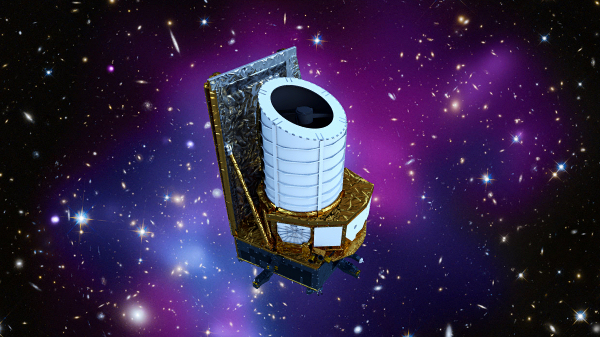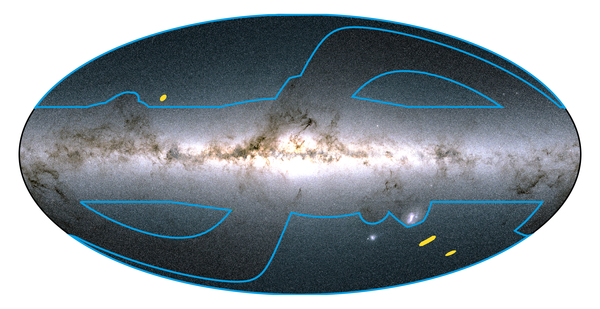Summary
Euclid is a medium-class mission in ESA's Cosmic Vision programme to investigate the expansion of our Universe over the past ten billion years, probing cosmic epochs from before the expansion started to accelerate, all the way to the present. To this aim, Euclid will survey galaxies at a variety of distances from Earth, over an area of the sky covering more than 35 percent of the celestial sphere.
 |
| Artist's impression of Euclid. Credit: ESA/ATG medialab (spacecraft); NASA, ESA, CXC, C. Ma, H. Ebeling and E. Barrett (University of Hawaii/IfA), et al. and STScI (background) |
Spacecraft, telescopes and instruments
The Euclid spacecraft will have a launch mass of around 2100 kg. It will be about 4.5 metres tall and 3.1 metres in 'diameter' (with appendages stowed). The nominal mission lifetime is six years.
The Euclid payload consists of a 1.2-m-aperture telescope with two instruments: the visual imager (VIS) and the near-infrared spectrometer and photometer (NISP).
Key questions
Euclid will help answering the following questions, among others:
- What is the distribution of dark matter in the Universe?
- What is the history of expansion of the Universe?
- What does this tell us about the nature of dark energy? Does the dark energy equation of state evolve over time?
- How do largescale structures form in the Universe?
How will Euclid tackle these questions?
Euclid is optimised for two primary cosmological probes:
- Weak gravitational Lensing (WL): Weak lensing is a method to map the dark matter distribution and determine the effect of dark energy by measuring the distortions of galaxy images by mass inhomogeneities along the line-of-sight.
- Baryonic Acoustic Oscillations (BAO): BAOs are wiggle patterns, imprinted in the clustering of galaxies on large scales, which provide a standard ruler to measure the expansion in the Universe and the acceleration caused by dark energy.
The Euclid survey
Euclid will survey the sky in a 'step-and-stare' mode: the telescope will point to a position in the sky, with imaging and spectroscopic measurements performed on an area of ~0.5 deg² around this position.
The sky coverage strategy is driven by the wide-survey requirement to cover 15 000 deg² of extragalactic sky (more than 35 percent of the celestial sphere) during the mission lifetime of 6 years. Additionally, a deep survey will be performed in three deep fields (40 deg² in total), reaching two magnitudes deeper than the wide survey.
 |
| The Euclid wide and deep surveys. Credit: ESA/Gaia/DPAC; Euclid Consortium. Acknowledgment: Euclid Consortium Survey Group |
Launch and orbit
Euclid will be launched from Europe's Spaceport in Kourou, French Guiana, on a Soyuz ST 2-1b launch vehicle that will place it onto a direct transfer orbit to its operational orbit.
The operational orbit – a large-amplitude (~ 106 km) halo orbit around the second Lagrange point of the Sun-Earth system (L2) – was selected because it offers optimum operating conditions for Euclid.
Synergies
Euclid will need additional data from ground-based telescopes, in order to improve photometric redshift determination, and Point-Spread Function (PSF) modelling for individual galaxies. Additional 4 band (u)griz photometry is considered, coming from the Pan-STARRS, Subaru and CFHT ground-based surveys. The volume of ground-based data will in fact be much larger than that of Euclid.
